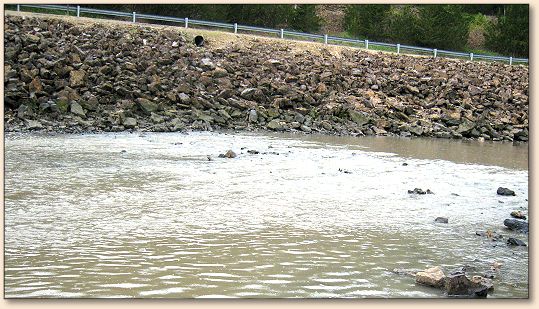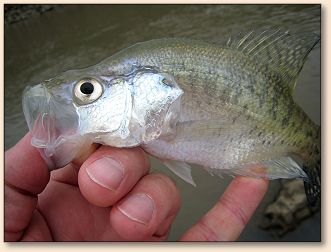|
Last Sunday my buddy, Donnie, and I drove to Toronto Lake and Fall
River Lake (both in Kansas) to scout them for fishing. A recent
state fishing report mentioning crappies in Toronto Lake ranging
from ¾ to 2 ½ pounds was a siren call we heard loud and clear.
Unfortunately for us (and everyone else, I suspect) both lakes were
extremely turbid – practically liquid mud – as a result of recent
heavy rains. Plus on the day of our arrival the wind was blowing
very hard, intensifying shoreline muddiness in the wave battered
areas that otherwise looked best to us for bank fishing.
On our drive home we stopped by Pomona Lake, located about 40 miles
southwest of Lawrence as the crow flies. Its water was muddy too.
I asked Donnie if he'd mind taking a quick look at the outlet
channel below the dam. Turned out the Corps of Engineers was
releasing water that day, at a volume I estimated around 500
cubic feet per second.
Under this condition (but especially during higher-volume draw
downs that are far more intense) a considerable number of lake
fish swimming happily in the vicinity of the dam find themselves
pulled inexorably toward the draw down tower. One minute they're
a lake fish, then comes a quick and curious trip through a conduit
tube and presto! they're in a man-made river channel living in a
whole new world. Many such displaced fish stay in the outlet
channel but most migrate downstream, eventually ending up in the
same place used electricity goes.
The trick is to catch 'em while they're still there in the outlet
channel. There are two schools of thought on the best way to do
it. 1) Fish the channel during the drawdown event by using heavier
tackle that lets you hold your own in the powerful exit current and
eddies. 2) Wait until the drawdown event is over, when the outlet
channel's water level drops and concentrates any fish still present
into a shallower, narrower and slower-current area that's better
suited to light tackle angling. Both disciplines have devotees.
Coming from an ultralight spinning background I've always gambled
on whatever's behind Curtain #2.
The Pomoma Lake outlet will forever hold a special place in my heart.
In 1969 I caught that year's U.S. record line-test walleye there.
It was my first-ever walleye. I didn't even know what the fish
was when it came into view; the angler near me who netted it for
me ID'd it. I also didn't know back then that walleyes are one
of the world's best-tasting fish. After weighing this curious
looking creature at an Ottawa, KS grocery store I took it home,
cleaned it and gave away the fillets. The following spring I read
in a Field & Stream magazine that the U.S. line-test record
for walleye for 1969 was a 7-pounder some guy had caught on 4-lb.
test line.
I'd caught my walleye, also a 7-pounder, on 2-lb. test line. Oh well!
My fond memory of Pomona Outlet also includes the many instances of
bang, bang action I had on crappie when tossing a tiny size 00 Mepps
spinner into the main pool then retrieving it just above the rocks.
This was great fun, especially the times when so many minnow and
bobber fishermen were sitting nearby drawing blanks.
On Sunday when we stopped there, Donnie was ready to get home so he
didn't want to give the outlet area a try even though he was using
ultralight spinning tackle. Looking at the outlet channel's current
speed, I wasn't sure it would do me any good to try, either. But my
eye was drawn to a small area of slack water that lay along the right
bank just below a slight shoulder. I'd caught many, many fish there
in the past. Might as well nymph that spot for a few minutes, just
for a drill. I did and ended up catching a few small crappies, then
we left.
Two days later, Tuesday, I was lying in bed early morning grumbling
to myself about the rotten weather forecast for that day. I looked
outside. Cloudy, but no rain falling. I got on my computer and
tubed up the real-time radar image for the Pomona Lake area. Pomona
was occupying the center of a wide storm-free corridor between two
active storm cells. Hmmm.
At 8:30 a.m. I got to the outlet and parked. To my happy surprise
the lake outflow had been reduced to maybe 75 cfs. At this lower
release volume Pomona's outlet divides into two distinct areas: a
stilling basin pool and below that, just past a man-made riffle,
lays the outlet's main pool.
The main outlet pool is where I caught that 7-lb. walleye and countless
other fish over past years. And what caught my breath today is that
nobody was fishing this larger pool. It was all mine. Being a retired
person does have its problems, I'm learning, but seeing this pool absent
of other people sure wasn't one of them.
Two men were vertical fishing the stilling basin, reaching over the
guardrail fence with their poles. I parked across the basin wall
from them, got out and lined up. Stepping to the fence on my side
of the guardrail, I offered a bit of friendly good morning talk and
discovered that the men opposite me are representatives of a species
frequently encountered at public access fishing spots in the state
of Kansas. I refer to the bib overall-clad Single Syllable Troglodyte.
"You fellas been rippin' into 'em?" asked I.
"Ungh."
"Well, it's sure cloudy today and might rain anytime, but at least
the wind isn't blowing a hurricane like it was Sunday. Wasn't that
awful?"
"Ungh."
I might never have torn myself away from such scintillating conversationalists
had I not looked downriver toward the large pool. There stood a Great Blue
Heron that had waded halfway across the man-made riffle at the end of the
stilling basin pool. Standing amidst those rocks with water gurgling past,
in a flicker of movement the bird harpooned then lifted into the air a
silvery fish that looked to be 8 or 9-inches long – maybe longer, maybe
bigger, because the heron quickly released it.
Well now! If a hungry heron is doing Catch & Release, who am I to
stand around making small talk when I can be down there nymphing
the area below that riffle?
It occurred to me a short time later that this trip marked the first
time I've fly fished the outlet of any federal lake. It would also
be the first time I've fly fished a riffle in Kansas. Granted, this
is a man-made riffle but the hydrology of Pomona Outlet's riffle
is what you will find in riffles pretty much everywhere.

Due to recent rains that had stained Pomona Lake's main body with
suspended sediment, even the reduced outflow volume hadn't improved
the water clarity in the outlet channel; it was still quite muddy.
This put serious doubt in my mind whether any fish would be able to
spot my nymph. To compensate, the tactic I employed initially was
to cast my nymph into the current border then commence a slow
up-current retrieve, the aim being to maximize the exposure time
when the nymph might be detected and attacked.
What made this whole business so comforting and familiar is that
it's the same technique I used for many years while ultralight
fishing in riffles and riffle pools using a tiny spinner. Except
with fly tackle and a nymph the technique was working even better.
Why? Because with fly fishing you have a wide choice of nymph
weights, and those choices give you the ability to probe any
given spot within or below a riffle with much greater deliberation.
So nymphing this riffle area turned out like all those great earlier
trips of catch and release fishing I enjoyed at this outlet while
using ultralight tackle and spinners. With my nymph I started
catching little 6-to-8 inch crappie like they were going out of style.
This sort of thing bores many people but has never bored me -- catching
lots of little fish, I mean. Because if the little ones are biting I
figure everything's biting, and you never know what'll hit on the next
cast during such times.
It's like eating popcorn in a movie theater; you just can't quit.
After I'd caught 125 crappies on one side of the outlet channel,
I switched sides to see what might be happening over there. This
change was spurred in part by curiosity about whether there might
be an isolated school of bigger crappies roaming around. I hadn't
ferreted out any such school where I'd been fishing, so why not try
across the channel? I walked around to the other side.
Almost the whole time I'd been catching those 125 little crappies,
the near-bank zone is where I was having the most luck. Just before
crossing the river, though, I'd sent a few casts across the riffle's
current chute, the chute on my side. Lifting my rod tip to maximum
height brought the floating line out of the current, leaving only
the narrower leader in contact with the water. This resulted in
some hookups in slower water areas out toward the center of the
riffle. So after I reached the opposite bank I decided to play
around with various presentations to see what would happen. One
of those presentations was to walk downstream, turn and cast back
upstream into the tail of the riffle and let the current wash my
nymph downstream in a free descent such as would happen if an actual
mayfly nymph had become dislodged in the riffle and got washed downstream?
To my amazement, I began catching crappies this way. They could
actually see my nymph in that dingy water as it zipped past them
at current speed! Maybe I shouldn't have been surprised by this
but their feeding behavior, this capability, was totally unexpected.
It was like these crappies were practicing how to work riffles the
way mountain stream trout do when they lie in ambush spots then rush
out to pick off passing insects. I've always admired crappie anyway,
but this feeding exhibition in a riffle increased my appreciation of
them.
By the time my back started hurting from being tensed up for three
hours it began raining. So I left Pomona Outlet having caught and
released 165 crappies, 1 channel cat, 1 bluegill and 1 white bass.
All of them small, but each great fun in moving water.

The day will come, it will certainly come, when I visit that outlet
and the fish are averaging lots longer and heavier. It's a bit
nerve-racking thinking how wild such a trip might be now that I've
seen what fly tackle can do in a Kansas riffle. I learned from that
walleye 38 years ago, and from many fish since, that the bigger ones
will not hesitate to grab a tiny moving thing that looks like real
food. In a limestone riffle what better object for them to attack
than a dead-on imitation of a nymph? ~ Joe
About Joe:
 From Douglas County, Kansas, Joe is a former municipal and
federal police officer, now retired. In addition to fishing, he hunts
upland birds and waterfowl, and for the last 15 years
has pursued the sport of solo canoeing. On the nearby
Kansas River he has now logged nearly 5,000 river miles
while doing some 400 wilderness style canoe camping
trips. A musician/singer/songwriter as well, Joe recently
retired from the U.S. General Services Adminstration.
From Douglas County, Kansas, Joe is a former municipal and
federal police officer, now retired. In addition to fishing, he hunts
upland birds and waterfowl, and for the last 15 years
has pursued the sport of solo canoeing. On the nearby
Kansas River he has now logged nearly 5,000 river miles
while doing some 400 wilderness style canoe camping
trips. A musician/singer/songwriter as well, Joe recently
retired from the U.S. General Services Adminstration.
Joe at one time was a freelance photojournalist who wrote the
Sunday Outdoors column for his city newspaper. Outdoor
sports, writing and music have never earned him any money,
but remain priceless activities essential to surviving the
former 'day job.'
|



 From Douglas County, Kansas, Joe is a former municipal and
federal police officer, now retired. In addition to fishing, he hunts
upland birds and waterfowl, and for the last 15 years
has pursued the sport of solo canoeing. On the nearby
Kansas River he has now logged nearly 5,000 river miles
while doing some 400 wilderness style canoe camping
trips. A musician/singer/songwriter as well, Joe recently
retired from the U.S. General Services Adminstration.
From Douglas County, Kansas, Joe is a former municipal and
federal police officer, now retired. In addition to fishing, he hunts
upland birds and waterfowl, and for the last 15 years
has pursued the sport of solo canoeing. On the nearby
Kansas River he has now logged nearly 5,000 river miles
while doing some 400 wilderness style canoe camping
trips. A musician/singer/songwriter as well, Joe recently
retired from the U.S. General Services Adminstration.